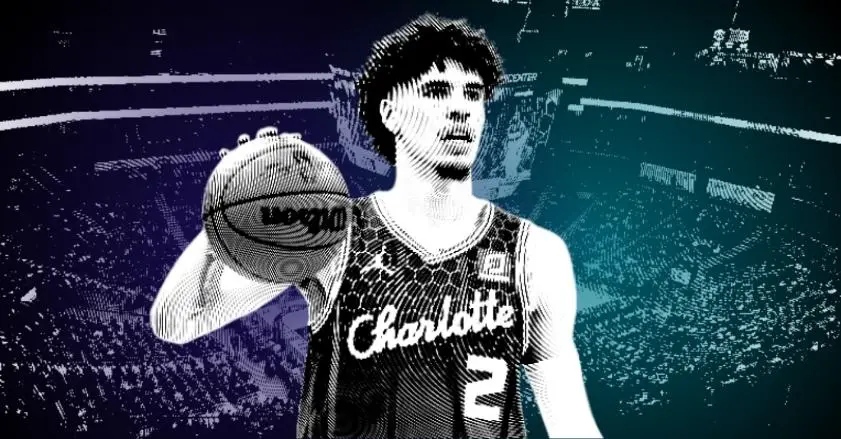The path of an NBA star is laid out and relatively simple to follow.
First, show flashes of a budding star as the world lifts you to unreasonable expectations, then fall after one mistake and everyone is ready to cast you aside. Finally, after years of experience and learning, rise above and reach the original heights and glory set upon you.
LaMelo Ball has seemingly had the entire first two steps in just two short years. He fell to third in the 2020 NBA Draft because of maturity concerns, but he blew everyone away with some flashy passes and a charismatic persona on his way to winning rookie of the year. Despite struggling in the Charlotte Hornets’ play-in loss to Indiana, the world felt conquerable to the youngest Ball brother.
In year two, things only got better. Charlotte won 10 more games in 2021-22 and Ball became the youngest player since LeBron James in 2005 to be named an NBA All-Star.
Just a few months removed from that game, where Ball was one of the key pieces in crunch time in Team Durant’s 163-160 loss, everyone feels out on Melo (or new Melo, for the Carmelo Anthony fans of the world) all of a sudden.
For a variety of reasons, there’s an argument to be had. Ball struggled for the second year in a row in a playoff environment, as the Hornets were blown out by the Atlanta Hawks in the play-in game. The next steps weren’t his fault, as Charlotte had the offseason from hell. They fired promising head coach James Borrego, and a mess of a coaching search brought back Steve Clifford for his second stint with the franchise.
Clifford has proven to be a fine head coach in the league during his time in Charlotte and Orlando, but the move felt… uninspiring at best. Just once in Clifford’s career has he guided a top-10 offense, and just one other time he led a team that was top 10 in pace. While he’s never worked with a player of Ball’s caliber, it’s fair to say people wished that the new boss in charge was someone a little more progressive, ready to build a team to Ball’s unique skill set. Clifford hasn’t proven he’s ready to do that through two different jobs.
The second part of the offseason was perhaps even more damaging. Miles Bridges, Ball’s high-flying, acrobatic wing from last season, faces 12 years in prison for domestic violence charges. While Bridges is set to due in court later this month, the news puts his future with the team and NBA in serious doubt. Perhaps one of the most improved players in the league last season, Bridges’ 20 points and seven rebounds per game create a hole in the Charlotte rotation.
It was leading to this point, where Charlotte has quickly become an afterthought in a now stacked Eastern Conference. A team that showed a lot of promise just three months ago, all of a sudden feels lottery bound.
For Ball, it seems like the struggles of the franchise are also passed on to him. If polled just six months ago, it would’ve been an overwhelming majority of people to take Ball first overall in a 2020 NBA redraft. Just this past week, ESPN’s NBArank 2022 had him 16 spots below fellow 2020 draftee Anthony Edwards, who has become a trendy darkhorse MVP candidate after leading the Minnesota Timberwolves to the first round of the NBA playoffs.
Ball outperformed Edwards by nearly every metric last season, including as a more efficient jump shooter and rebounder along with his patented playmaking that Edwards has never been close to matching. Ball also showed great improvements on the defensive side of the ball compared to Edwards, ranking in the positive on advanced defensive metrics and averaging 1.6 steals per game. In nearly every facet of the game, Ball outperformed Edwards again.
Adding insult to injury, Ball was also ranked behind other young phenoms like Zion Williamson, Scottie Barnes, Evan Mobley, and Cade Cunningham, all of whom did not sniff an all-star team last season. Through no fault of his own, Ball’s star has fallen almost impossibly more quickly than it rose.
It’s hard to separate the player from the team sometimes. The Hornets are very much in a dark place right now as a franchise compared to last summer, but this isn’t an utterly barren roster. Ball is a master technician on the offensive end of the court, and his superpowers are an elite understanding of passing angles, spacing, and the ability to decipher defenses on the fastbreak. A healthy Gordon Hayward will help (I know, I know… sigh), but the supporting cast of Terry Rozier, PJ Washington, and Kelly Oubre Jr., while further development from Jalen McDaniels and James Bouknight could offer even more offensive weaponry to work with.
There’s still a glimmer of hope that’s being overlooked and that’s the “falling” star of LaMelo. While the play-in results have left much to be desired, it’s undeniable that Ball is still one of the most skilled and creative guards the league has today. We’ve seen star players lift mediocre teams in the past, and Ball has outperformed our expectations in each of his first two seasons. Why then, in year three, should we expect anything less?

